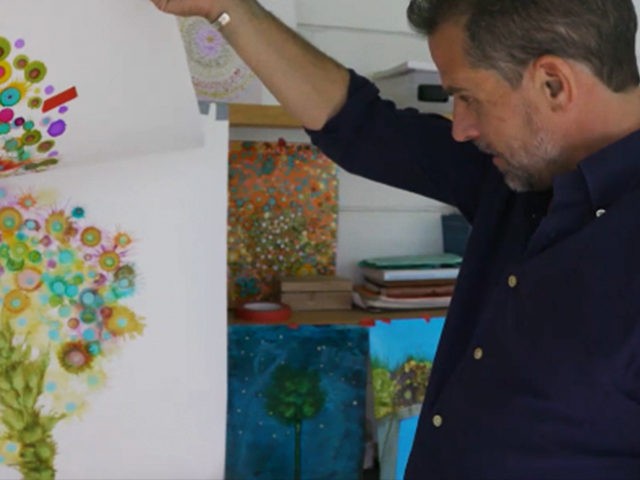A mystery buyer reportedly spent $875,000 on 11 Hunter Biden paintings from his art dealer, who operates within an industry known for secrecy, anonymity, and money laundering.
A document obtained by Business Insider shows a mysterious individual purchased 11 paintings for $875,000. The contract does not specify the identity of the buyer. The report did reveal the buyer lives outside New York and bought Hunter Biden’s largest in size paintings, including a 12-foot-long artwork on sheet metal entitled “Pandemonium.”
“A gallery contract with Hunter Biden’s handwritten edits show him excluding the sales of NFTs from the gallery’s 40 percent commission,” Insider reported. “That one buyer represents the majority of the $1,379,000 in receipts that Hunter Biden’s gallery received for his work, the documents show, with the gallery receiving a 40 to 45 percent commission.”
Hunter’s art dealer, Georges Bergès, previously boasted strong ties to businessmen in Communist China. In 2015, Bergès planned to be the “lead” Chinese art dealer, as President Joe Biden’s son finalized deals with Chinese officials and made tens of thousands of dollars per month serving on the board of Burisma in 2014.
Bergès also admitted in 2014 he travels to Communist China “three or four times a year” and that he had a “solid group of about 25 collectors, most of them overseas.”
The purchaser of Hunter Biden’s art reportedly visited Joe Biden’s White House 13 times after the president’s son first showcased his paintings at his art dealer’s gallery in New York City. https://t.co/JA9g5OpgJF
— Breitbart News (@BreitbartNews) July 25, 2023
In 2016, an investor in his gallery reportedly sued Bergès for fraud and breach of contract. In another instance of reported wrongdoing, before filing for personal bankruptcy in 1998, authorities arrested Bergès in California and charged him “with assault with a deadly weapon and ‘terrorist threats,’ according to public records from the Santa Cruz Police Department.”
Bergès links to Communist China, along with his shady past, did not prevent Bergès from setting the prices for Hunter Biden’s paintings while withholding “all records, including potential bidders and final buyers.”
Former White House press secretary Jen Psaki previously defended Hunter’s artwork as “reasonable, suggesting the president’s son “is not involved in the sale or discussions about the sale of his art,” and that he will not be “informed” of “who is purchasing his art.”
The art industry is known for shady business transactions. A Senate subcommittee report detailed in 2020 how the art market serves as a vehicle for money laundering:
The art industry is considered the largest, legal unregulated industry in the United States. Unlike financial institutions, the art industry is not subject to Bank Secrecy Act’s (“BSA”) requirements, which mandate detailed procedures to prevent money laundering and to verify a customer’s identity. While the BSA does not apply to art transactions by art dealers and auction houses, sanctions do. No U.S. person or entity is allowed to do business with a sanctioned individual or entity.
…
While the art market is not regulated by the BSA, it is governed by unwritten rules. A large number of art sales happen through intermediaries referred to as “art advisors” who can represent both purchasers and sellers. In a typical transaction, a purchaser may not ask who owns the piece of art they are purchasing; the seller may not ask for whom it is being purchased or the origin of the money. And in general an art advisor would be reluctant to reveal the identity of their client for fear of being cut out of the deal and losing the business.
…
Because the art industry is not subject to BSA requirements, when a piece of art is sold, there is no legal requirement for the selling party to confirm the identity of the buyer or that the buyer is not laundering money through the purchase. While the four biggest auction houses have voluntary anti-money laundering (“AML”) programs, the employees who facilitated art purchases in the Subcommittee’s case study said they never asked the art advisor the identity of his client. Instead, the auction houses considered the art advisor the principal purchaser and performed any due diligence on the art advisor, even when it was well-known that the ultimate owner was someone else. With regard to the funds used to purchase art, the auction houses told the Subcommittee they rely on financial institutions to ensure the integrity of the funds, even though the auction houses interact directly with the buyer. But these voluntary AML policies are just for sales through the auction houses. As stated above, the majority of art sales are private transactions. A private dealer interviewed by the Subcommittee stated she had no written AML policies, tries to work with people she knows and trusts, looks for red flags, and relies on her gut. She also explained that her practices have significantly changed over the years and that she also relies on advice from AML lawyers.
Secrecy, anonymity, and a lack of regulation create an environment ripe for laundering money and evading sanctions.
Follow Wendell Husebø on Twitter @WendellHusebø. He is the author of Politics of Slave Morality.

COMMENTS
Please let us know if you're having issues with commenting.